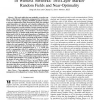Free Online Productivity Tools
i2Speak
i2Symbol
i2OCR
iTex2Img
iWeb2Print
iWeb2Shot
i2Type
iPdf2Split
iPdf2Merge
i2Bopomofo
i2Arabic
i2Style
i2Image
i2PDF
iLatex2Rtf
Sci2ools
TSP
2010
2010
Randomized and distributed self-configuration of wireless networks: two-layer Markov random fields and near-optimality
Abstract--This work studies the near-optimality versus the complexity of distributed configuration management for wireless networks. We first develop a global probabilistic graphical model for a network configuration which characterizes jointly the statistical spatial dependence of a physical- and a logical-configuration. The global model is a Gibbs distribution that results from the internal network properties on node positions, wireless channel and interference; and the external management constraints on physical connectivity and signal quality. A local model is a two-layer Markov Random Field (i.e., a random bond model) that approximates the global model with the local spatial dependence of neighbors. The complexity of the local model is defined through the communication range among nodes which corresponds to the number of neighbors in the two-layer Markov Random Field. The local model is near-optimal when the approximation error to the global model is within a given bound. We analy...
| Added | 22 May 2011 |
| Updated | 22 May 2011 |
| Type | Journal |
| Year | 2010 |
| Where | TSP |
| Authors | Sung-eok Jeon, Chuanyi Ji |
Comments (0)

